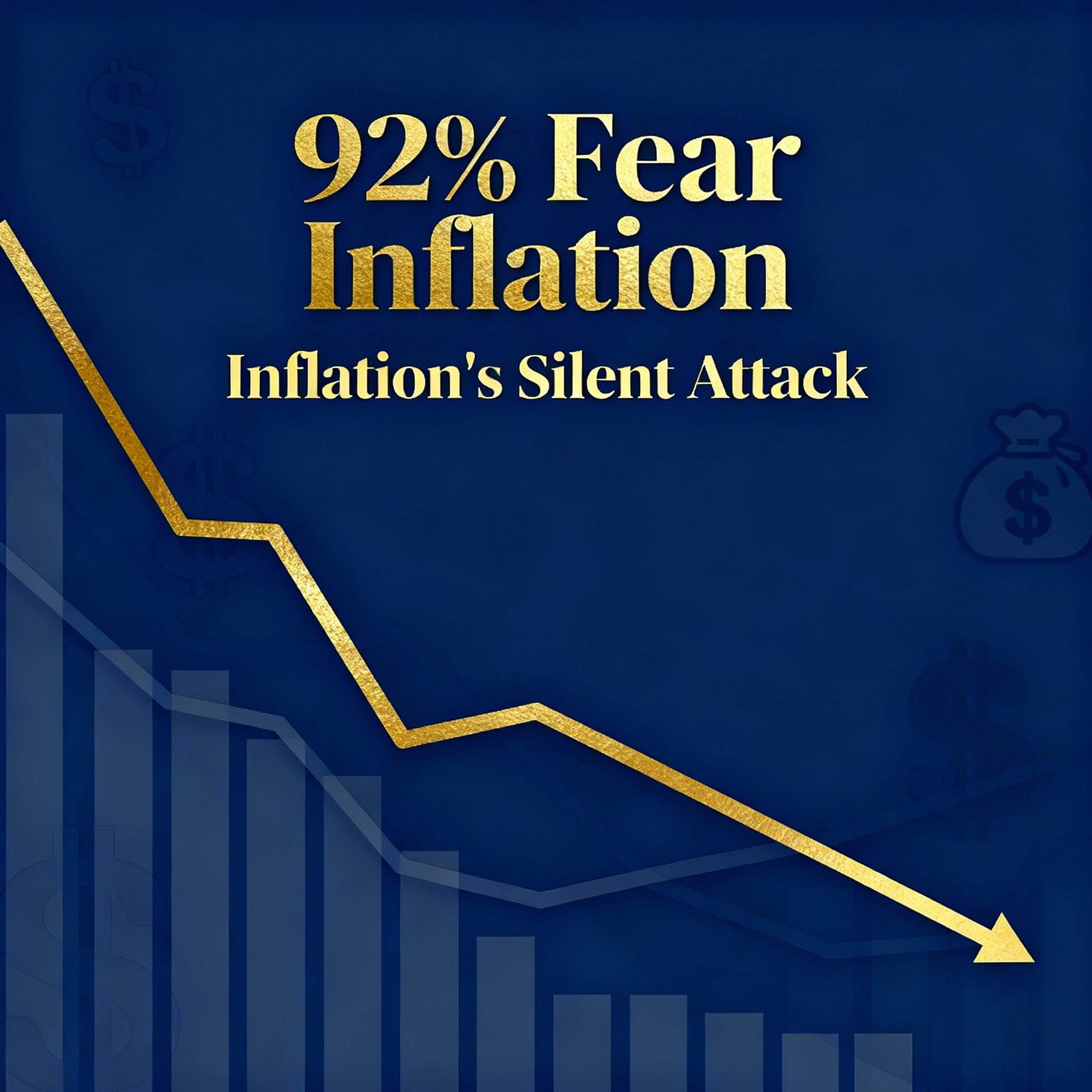The Enemy Nobody Talks About: Inflation in Retirement
It’s not market crashes. It’s not bad financial decisions. The biggest threat to retirement security, according to a 2025 Schroders study, is something far more insidious: inflation.
A staggering 92% of retirees worry about inflation eroding their purchasing power, and their concern is justified. While most people obsess over market volatility, inflation quietly destroys retirement plans year after year.
RETIREES WORRIED ABOUT INFLATION
92%
Rate of concern from Schroders 2025 study
Even worse, 45% of current retirees report that their actual expenses are higher than they expected—directly attributable to inflation outpacing their income.
How Inflation Destroys a Fixed-Income Retirement
Imagine you retire with a plan to live on $4,000 per month. Sounds reasonable, right? Now watch what happens with just 3% average inflation:
| Year | Monthly Spending Needed | Annual Total | Cumulative Increase |
|---|---|---|---|
| Year 1 (Retirement) | $4,000 | $48,000 | — |
| Year 5 | $4,637 | $55,644 | +16% |
| Year 10 | $5,372 | $64,464 | +34% |
| Year 15 | $6,213 | $74,556 | +55% |
| Year 20 | $7,186 | $86,232 | +80% |
| Year 25 | $8,326 | $99,912 | +108% |
Assumes 3% average annual inflation. Your $4,000/month budget doubles in 25 years.
🚨 REALITY CHECK: That $4,000 retirement budget more than doubles over a 25-year retirement. Most retirees don’t account for this, and their savings run dry 10-15 years into retirement.
The Inflation Reality: Recent History vs. Future Projections
| Period | Inflation Rate | Impact on Retirees |
|---|---|---|
| 2020-2021 | 1.4% (average) | Low inflation, stable budgets |
| 2022 | 8.0% | Crisis: costs jump 8% in ONE year |
| 2023 | 4.1% | Still above historical average |
| 2024 | 2.6% | Moderating but persistent |
| 2025-2026 (Projected) | 2.5-3.5% | Back to “normal” but still eating savings |
Sources: U.S. Bureau of Labor Statistics, Federal Reserve projections
The Social Security COLA Trap
Many retirees think Social Security Cost-of-Living Adjustments (COLA) protect them from inflation. They don’t.
| Year | Inflation Rate | Social Security COLA | Real Loss |
|---|---|---|---|
| 2022 | 8.0% | 8.7% | +0.7% (caught up!) |
| 2023 | 4.1% | 3.2% | -0.9% (lost ground) |
| 2024 | 2.6% | 3.2% | +0.6% (ahead) |
| 2025 (Estimated) | 3.0% | 2.3% | -0.7% (lag) |
COLA adjustments are based on 12-month averages, creating lag periods where benefits trail actual inflation
Social Security COLA adjustments typically lag inflation by 6-12 months, meaning your benefits lose ground during inflationary periods.
Which Expenses Get Hit Hardest by Inflation?
Not all expenses inflate equally. For retirees, some categories increase far faster than general inflation:
| Expense Category | Inflation 2020-2025 | Annual Rate | Retirement Impact |
|---|---|---|---|
| Housing/Shelter | +22.5% | 4.2% | Most vulnerable retirees |
| Utilities/Energy | +33.0% | 5.9% | Heating/cooling critical at older ages |
| Healthcare | +28.4% | 5.1% | Devastating for fixed-income retirees |
| Food/Groceries | +24.1% | 4.4% | Basic necessity with no flexibility |
| General CPI | +18.2% | 3.4% | Average inflation measure |
Source: Bureau of Labor Statistics 2020-2025
⚠️ THE TRUTH:
Retirees aren’t spending their money proportionally to the economy. They spend MORE on housing, utilities, and healthcare—all of which inflate faster than general inflation. This means retirees experience higher inflation than the headline number.
How to Combat Inflation in Retirement
6 Strategies to Inflation-Proof Your Retirement
1. Build Inflation-Protected Income Streams
- Delayed Social Security: Each year you delay increases benefits by 8% (=inflation hedge)
- Treasury Inflation-Protected Securities (TIPS): Guaranteed inflation protection
- I-Bonds: Current rate adjusts semi-annually to inflation (limited to $10K/year)
- Dividend growth stocks: Companies raising dividends historically beat inflation
2. Maintain Inflation-Adjustable Withdrawals
- Don’t use fixed 4% rule withdrawal; adjust for inflation annually
- Reduce withdrawals in down market years to preserve capital
- Keep 2-3 years expenses in cash to avoid panic selling
3. Lock In Fixed Costs Where Possible
- Pay off mortgage before retirement if possible
- Consider fixed-rate utilities lock-ins
- Long-term care insurance locks in rates before they inflate
4. Maintain Flexible Spending Categories
- Travel, dining, entertainment can be reduced in inflation periods
- Healthcare, utilities, housing less flexible (must plan accordingly)
- Build buffer for essential fixed expenses
5. Consider Part-Time Work or Gig Income
- Even $500-1,000/month part-time work combats inflation
- Consulting, freelance work, seasonal employment
- Provides inflation-hedge income plus delays Social Security
6. Plan for Inflation in Your Retirement Number
- Don’t use today’s dollars for retirement planning
- Assume 3% annual inflation minimum
- Recalculate your retirement number: 3% higher annually
- Save 10-20% MORE than your base calculation
The Bottom Line
Inflation isn’t something that happens TO your retirement—it’s something you must actively plan FOR. The 92% of retirees worried about inflation are rightfully concerned. But those who account for it proactively can build resilience.
Remember: Over a 25-year retirement, inflation at just 3% per year means your living costs will more than double. Account for it now, or watch your retirement security disappear year by year.
Are you planning for inflation in retirement? What’s your strategy for maintaining purchasing power? Share your thoughts in the comments below.
About the Author: Robert Chen is a Retirement Finance Analyst at RetireMetric.com, specializing in inflation-resistant retirement strategies and long-term financial planning.

Leave a Reply